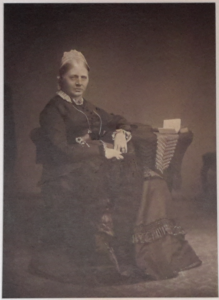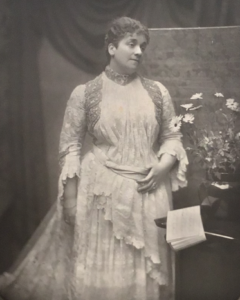I have recently been looking through the early Annual Reports of the British Women’s Temperance Association, as we are planning to have these digitised for research purposes. This provided me with a good opportunity to take a look at the numbers of branches and members of the BWTA, which were reported on an annual basis. I was hoping to see if the numbers would tell a story and provide an insight into the rise and decline of the British Women’s Temperance Association, which was the foremost women’s temperance society of the 19th century.
Although the statistics recorded in the reports of the association are not always of a consistent format, they do appear to indicate certain peaks and troughs in numbers, which coincide with events which impacted on the organisation as a whole, both positively and negatively.
The British Women’s Temperance Society (BWTA) was formed in the 19th century, following the formation of the earliest temperance societies in the UK in the 1830’s. Alcohol consumption was seen as a grave danger to the wellbeing of society and so the campaign against the consumption of alcohol and drunkenness began in earnest.
 When the BWTA was formed in Newcastle upon Tyne in 1876, there were already women’s temperance societies in existence but the object of the association was to form a union of women’s temperance societies all over the country. The very first Annual Report of the association records 8 branches in total, which steadily rose into the hundreds during the 1880’s when Margaret Bright Lucas was President. In a tribute to Lucas following her death it was written, ‘It is undoubtedly to her untiring energy that we can trace to a large degree the position of women to-day, especially in matters relating to temperance, and….the growth of the movement in all parts of the country, and to be instrumental with others in forming many of the existing Branches.’ By the time that Lucas died in 1890 and 14 years after the BWTA was founded, there were around 500 branches across the country.
When the BWTA was formed in Newcastle upon Tyne in 1876, there were already women’s temperance societies in existence but the object of the association was to form a union of women’s temperance societies all over the country. The very first Annual Report of the association records 8 branches in total, which steadily rose into the hundreds during the 1880’s when Margaret Bright Lucas was President. In a tribute to Lucas following her death it was written, ‘It is undoubtedly to her untiring energy that we can trace to a large degree the position of women to-day, especially in matters relating to temperance, and….the growth of the movement in all parts of the country, and to be instrumental with others in forming many of the existing Branches.’ By the time that Lucas died in 1890 and 14 years after the BWTA was founded, there were around 500 branches across the country.
 There followed a noticeable peak in the increase of branch numbers recorded, during the Presidency of Lady Henry Somerset. Her presidential term ran for thirteen years, from 1890 to 1903 and she was hugely influential in her role. Lady Henry Somerset was a charismatic leader and speaker and although her presidency was not without controversy, branch numbers appeared to have doubled from 500 to over 1100. Even after a split in the organisation over a dispute in policy, which saw a number of high profile members leave to form a separate society, the numbers continued to climb under her direction. Part of her legacy as leader was the implementation of a clear departmental structure for the association, based on different categories of work.
There followed a noticeable peak in the increase of branch numbers recorded, during the Presidency of Lady Henry Somerset. Her presidential term ran for thirteen years, from 1890 to 1903 and she was hugely influential in her role. Lady Henry Somerset was a charismatic leader and speaker and although her presidency was not without controversy, branch numbers appeared to have doubled from 500 to over 1100. Even after a split in the organisation over a dispute in policy, which saw a number of high profile members leave to form a separate society, the numbers continued to climb under her direction. Part of her legacy as leader was the implementation of a clear departmental structure for the association, based on different categories of work.
 The number of branches and members continued to rise when Rosalind Countess of Carlisle took over the role of President in 1903. By this point there were over 104,000 members country wide, as recorded in the reports. Known as ‘The Radical Countess,’ Rosalind was strong minded and had a keen interest in politics and under her leadership the BWTA continued to flourish. The report for 1914 records the highest number of branches and members during the history of the association – 1945 branches with over 164,000 members.
The number of branches and members continued to rise when Rosalind Countess of Carlisle took over the role of President in 1903. By this point there were over 104,000 members country wide, as recorded in the reports. Known as ‘The Radical Countess,’ Rosalind was strong minded and had a keen interest in politics and under her leadership the BWTA continued to flourish. The report for 1914 records the highest number of branches and members during the history of the association – 1945 branches with over 164,000 members.
The advent of the First World War pinpoints the beginning of the overall decline in numbers across the BWTA. New laws were imposed on the public including the Defence of The Realm Act of 1914, which brought about widespread restrictions on alcohol consumption. There was a brief resurgence in BWTA numbers in the early 1920’s under Rosalind’s leadership. Notably, in 1926 the Women’s Total Abstinence Union re-united with the BWTA following their earlier split over policy. An increase to pre-war figures can be seen although this was followed immediately by the downward trend seen after 1914.
During the inter-war years, although the number of branches levelled off, the number of members was decreasing at higher rate. There were now less members per branch on average. In 1939 at the beginning of the Second World War, 108,000 members were reported and by the end this had dropped to 63,200. This drop in numbers is nearly double that which had occurred following the First World War. There are no Annual Reports for 1941-1945 and when the next one was published in 1946, it acknowledged the difficulties in providing accurate statistics for this period of war. However, the evidence from the ensuing reports up to 1954, sadly suggest that this may have been a fairly accurate representation of the society and its position. By 1954 there were just 39184 members recorded across 731 branches, as against around 164800 members and 1945 branches at its peak in 1914, terms of numbers.
Social and economic changes played their part in the decline of the temperance movement as a whole and also the BWTA. Changing attitudes to alcohol consumption would also have been a contributing factor. The records of the BWTA provide a picture of this decline. We also acknowledge the changing roles of women in society and the effect this may have had on the structure of the BWTA and the ability to engage and recruit more members.
Whilst we are no longer the temperance society that we once were, we are proud that today as the White Ribbon Association, we still continue to support the local community by promoting healthy life styles. The numbers may tell us a story of decline but the story continues….
